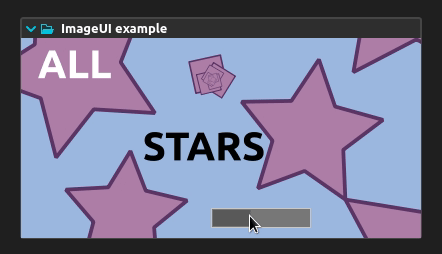Custom items
Supported bindings: ossia
One can also define and use custom items. This is however very experimental and only support in the ossia bindings so far :-)
Non-interactive items
Here is a non-interactive item:
struct custom_anim
{
// Static item metadatas: mandatory
static constexpr double width() { return 200.; }
static constexpr double height() { return 200.; }
static constexpr double layout() { enum { custom } d{}; return d; }
// In practice with the helpers, we use a type with the mandatory parts
// already defined and just focus on our item's specificities ; this is
// enabled by this typedef.
using item_type = custom_anim;
// Item properties: those are mandatory
double x = 0.0;
double y = 0.0;
double scale = 1.0;
// Our paint method. avnd::painter is a concept which maps to the most usual
// canvas-like APIs. It is not necessary to indicate it - it just will give better
// error messages in case of mistake, and code completion (yes) in IDEs such as QtCreator
void paint(avnd::painter auto ctx)
{
constexpr double cx = 30., cy = 30.;
constexpr double side = 40.;
ctx.set_stroke_color({.r = 92, .g = 53, .b = 102, .a = 255});
ctx.set_fill_color({173, 127, 168, 255});
ctx.translate(100, 100);
ctx.rotate(rot += 0.1);
for(int i = 0; i < 10; i++)
{
ctx.translate(10, 10);
ctx.rotate(5.+ 0.1 * rot);
ctx.scale(0.8, 0.8);
ctx.begin_path();
ctx.draw_rect(-side / 2., -side / 2., side, side);
ctx.fill();
ctx.stroke();
}
ctx.update();
}
double rot{};
};
This produces the small squares animation here:

Interactive items for controlling single ports
This is even more experimental :)
Here is what I believe to be the first entirely UI-library-independent UI slider defined in C++.
// This type allows to define a sequence of operations which will modify a value,
// in order to allow handling undo-redo properly.
// The std::function members are filled by the bindings.
template<typename T>
struct transaction
{
std::function<void()> start;
std::function<void(const T&)> update;
std::function<void()> commit;
std::function<void()> rollback;
};
// look ma, no inheritance
struct custom_slider
{
// Same as above
static constexpr double width() { return 100.; }
static constexpr double height() { return 20.; }
// Needed for changing the ui. It's the type above - it's already defined as-is
// in the helpers library.
halp::transaction<double> transaction;
// Called when the value changes from the host software.
void set_value(const auto& control, double value)
{
this->value = avnd::map_control_to_01(control, value);
}
// When transaction.update() is called, this converts the value in the slider
// into one fit for the control definition passed as argument.
static auto value_to_control(auto& control, double value)
{
return avnd::map_control_from_01(control, value);
}
// Paint method: same as above
void paint(avnd::painter auto ctx)
{
ctx.set_stroke_color({200, 200, 200, 255});
ctx.set_stroke_width(2.);
ctx.set_fill_color({120, 120, 120, 255});
ctx.begin_path();
ctx.draw_rect(0., 0., width(), height());
ctx.fill();
ctx.stroke();
ctx.begin_path();
ctx.set_fill_color({90, 90, 90, 255});
ctx.draw_rect(2., 2., (width() - 4) * value, (height() - 4));
ctx.fill();
}
// Return true to handle the event. x, y, are the positions of the item in local coordinates.
bool mouse_press(double x, double y)
{
transaction.start();
mouse_move(x, y);
return true;
}
// Obvious :-)
void mouse_move(double x, double y)
{
const double res = std::clamp(x / width(), 0., 1.);
transaction.update(res);
}
// Same
void mouse_release(double x, double y)
{
mouse_move(x, y);
transaction.commit();
}
double value{};
};
// This wraps a custom widget in all the data which is mandatory to have so that we do not have to repeat it.
// This is also already provided in the helper library ; using it looks like:
//
// halp::custom_item<custom_slider, &inputs::my_control>
template<typename T, auto F>
struct custom_item
{
static constexpr double layout() { enum { custom } d{}; return d; }
using item_type = T;
double x = 0.0;
double y = 0.0;
double scale = 1.0;
decltype(F) control = F;
};
Painter API
Here is the complete supported API so far:
#pragma once
/* SPDX-License-Identifier: GPL-3.0-or-later OR BSL-1.0 OR CC0-1.0 OR CC-PDCC OR 0BSD */
namespace avnd
{
template <typename T>
concept painter = requires(T t) {
// Paths:
t.begin_path();
t.close_path();
t.stroke();
t.fill();
// x , y
t.move_to(0., 0.);
t.line_to(0., 0.);
// x , y , w , h , startAngle, arcLength
t.arc_to(0., 1., 2., 3., 11., 12.);
// c1x, c1y, c2x, c2y, endx, endy
t.cubic_to(0., 1., 2., 3., 11., 12.);
// x1, y1, x2, y2
t.quad_to(0., 1., 2., 3.);
// Transformations:
// x , y
t.translate(0., 0.);
t.scale(0., 0.);
t.rotate(0.);
t.reset_transform();
// Colors:
// R G B A
t.set_stroke_color({255, 255, 255, 127});
t.set_stroke_width(2.);
t.set_fill_color({255, 255, 255, 127});
// Text:
t.set_font("Comic Sans");
t.set_font_size(10.0); // In points
// x , y , text
t.draw_text(0., 0., "Hello World");
// Drawing
// x1, y1, x2 , y2
t.draw_line(0., 0., 10., 10.);
// x , y , w , h
t.draw_rect(0., 0., 10., 10.);
// x , y , w , h , r
t.draw_rounded_rect(0., 0., 10., 10., 5.);
// x , y , filename
t.draw_pixmap(0., 0., "pixmap");
// x , y , w , h
t.draw_ellipse(0., 0., 10., 10.);
// cx, cy, radius
t.draw_circle(0., 0., 20.);
// x, y, w, h, bytes, img_w, img_h
t.draw_bytes(0., 0., 0., 0., (unsigned char*)nullptr, 0, 0);
t.draw_bytes(0., 0., 0., 0., (float*)nullptr, 0, 0);
};
}